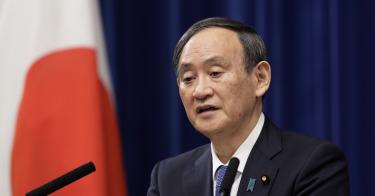North Korea’s escalating nuclear and missile threats pose a security and moral dilemma for Japan: How should it deter and defend against an existential national security threat while remaining true to its constitutional ideals?
Japan responded to increasing Chinese incursions into its territorial waters and airspace by strengthening its forces to defend against attacks on the southwest islands. The Self-Defense Forces augmented air- and sea-launched missile capabilities to target invading Chinese units.
But, to date, Tokyo has reserved discussion of attacking enemy targets on foreign soil to North Korean contingencies.
The International Atomic Energy Agency’s recent assessment that Pyongyang had resumed operations at its Yongbyon nuclear reactor will exacerbate concerns of the North Korean nuclear threat to Japan.
>>> North Korea Ramps Up Nuclear Weapons Production
Japan’s legal interpretation of what is allowed under its peace Constitution has evolved slowly toward a more active military posture. It is, obviously, in Japan’s national interest to develop counterattack strike capabilities to reduce the North Korean missile threat to its populace.
But doing so entails overcoming difficult constitutional, legal, budgetary, technical and societal hurdles that would signal a significant shift from its long-standing post-World War II security posture.
A Liberal Democratic Party policy committee concluded in July 2020 that Japan needs to “consider ways to strengthen deterrence, including having the capability to halt ballistic missile attacks within the territory of our adversaries.” Then-Prime Minister Shinzo Abe agreed that missile defenses alone were insufficient for maintaining deterrence or protecting Japan.
However the Yoshihide Suga administration deferred on a decision to develop strike capabilities, instead relegating the issue to further study.
Debate whether Japan would be allowed under its Constitution to have such capability can be traced back to 1956, when then-Prime Minister Ichiro Hatoyama assessed that attacking enemy bases could be justified in terms of the right of self-defense. He concluded that if Japan faced an imminent missile attack, “I simply cannot believe that the spirit of the Constitution requires that we merely sit and wait to die.”
Since that foundational statement, subsequent Japanese administrations consistently asserted that Japan had the authority under the U.N. charter to conduct retaliatory attacks on enemy targets after Japan had been initially struck by missiles and undertaken to prevent additional attacks.
Even the creation of the Self-Defense Forces after World War II was initially determined to be unconstitutional—until it was not. Similarly, signing Japan’s defense treaty with the United States, allowing Japanese forces to participate in U.N. peacekeeping operations and allowing collective self-defense were all originally perceived as contrary to the Constitution’s post-war restrictions, but were eventually accepted.
Then what to do in the face of threats like North Korea? Pyongyang’s development of nuclear weapons escalated the risks of Tokyo continuing to rely solely on passive missile defense, which, if overwhelmed, would have catastrophic results.
Instead, a Japanese ability to “shoot the archer,” rather than intercepting all incoming arrows, would degrade Pyongyang’s ability to conduct follow-on attacks and thereby reduce additional casualties and destruction.
Furthermore, being able to hold enemy targets at risk increases the price of any attack on Japan, thereby enhancing deterrence and regional stability while degrading an opponent’s attempts at coercion. Having indigenous strike capabilities, especially if integrated into an alliance structure, could ameliorate Japanese concerns about the continued viability of the U.S. extended deterrence guarantee.
While Japan acquiring strike capabilities would be militarily advantageous, numerous barriers must be overcome. Japan has yet to articulate the missions and parameters for such forces, the strike weapons to be procured and whether it would develop independent targeting capabilities or rely on U.S. resources.
Since the Self-Defense Forces lack requisite intelligence, surveillance and other capabilities necessary for dynamic real-time targeting, Japan would need to incorporate any strike missions into the overall alliance structure.
Developing, deploying and maintaining new military capabilities is costly in both monetary terms and lost opportunities. As with any budget, new requirements either must be accomplished through additional overall funding or through decreased emphasis on existing missions, including stretching out development timelines.
Tokyo’s constrained defense expenditures hinder the country’s ability to fulfill its ambitious security plans, let alone a major new mission. In order to develop strike capabilities, Japan will have to significantly augment defense spending and break the arbitrary, politically self-imposed 1% of GDP cap. Otherwise, the initiative will come at the expense of other critical defense missions.
The Japanese populace remains deeply suspicious of the use of the military as a policy instrument and fearful that any easing of constraints will lead Japan into military conflict. Komeito, the LDP’s coalition partner, has indicated it does not support developing long-range strike capabilities.
Japan’s neighbors, all of which have long-range strike capabilities, would seek to deny Tokyo the same capability by warning that any enhancement in the country’s military capabilities risks a resurgence of imperialistic militarism.
Prime Minister Hatoyama’s 1956 statement provided the foundation for allowing Japanese strike capabilities, but nearly 70 years later, Japan continues to debate doing so. Progress in altering the nation’s security posture has always lagged behind faster-moving regional threats. Any change in Japan’s security posture requires a great amount of time, effort and outside pressure to overcome political and public resistance.
Tokyo’s decision to cancel the defensive Aegis Ashore project due to local resistance does not bode well for gaining approval for deploying offensive systems to enable strike capabilities. It will require a dedicated and powerful prime minister to convince the Japanese public to accept a dramatic expansion of Japan’s post-war security role.
This piece originally appeared in The Japan Times



